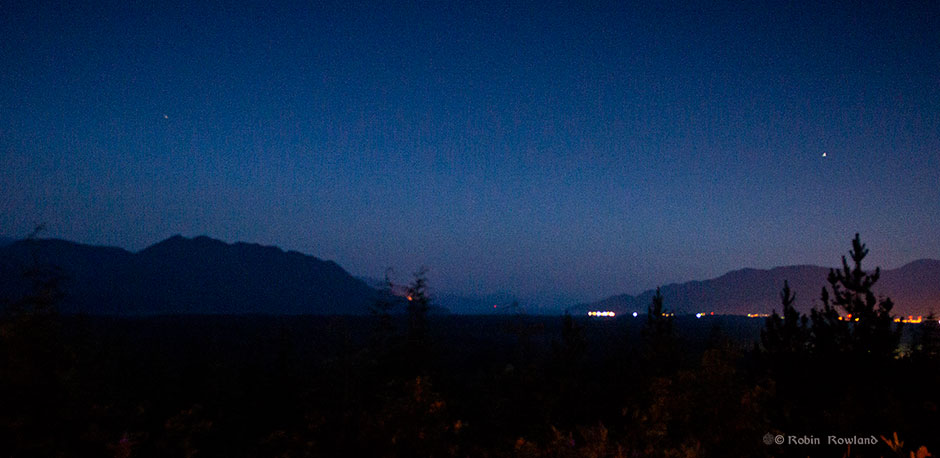Moon, Mars and a meteor over Minette Bay (plus other celestial wonders)

This week is a stargazer’s delight. Mars is at its closest approach to Earth, and that means the Red Planet is the brightest it will be from July 27 to July 31 (the latter date is when Mars is actually the closest). Although North America missed the solar eclipse earlier this week, the moon is actually at its smallest, sometimes called a Buck Moon. The giant planets Saturn and Jupiter are high in the southern sky this week. Earlier in the month, Venus was visible as the Evening Star and for those with the proper gear it was possible to get a glance of Mercury.
Kitimat is in the midst of the summer heat wave that is gripping most of North America. Nights are mostly clear although there is some high haze from smoke in the atmosphere stemming from the forest fires in both Siberia and North America.
With all that I drove out to the Kitimat Viewpoint late Saturday July 28, to capture it all.
Gear
Apps (for Android)
The Photographer’s Emphemeris
– told me when the moon will rise and the angle of location. Note: TPE gives moonrise at sea level. That means moonrise in Kitimat is usually between 50 and 70 minutes later depending on where it comes up over the mountains.
A compass app. To check the compass direction of the moonrise as predicted by TPE.
Sky Map. Android app originally developed by Google. Hold up you phone and see location of stars, planets, nebulae, satellite etc.
Camera
Heavy duty Manfrotto tripod
with
Sony Alpha 77, Minolta 17 to 35mm wide angle lens
Mounted with Cokin P121L Neutral density filter (to reduce the glare from the moon)
Handheld
Sony RX10iii
Jupiter and Saturn over Douglas Channel

The late summer dusk lingers for more than hour after sunset, so even the distant mountains of Douglas Channel can be seen. Jupiter is bright over the Rio Tinto plant at 10:50:33
Sony Alpha 77 ISO 4000 F2.8 1/2.5 of a second
Moonrise


The first arc of the moon peeked over the mountaintop at about 10:57:40.
The first image in the photoblog was taken at 11:00:23 and the second at 11::02:27
Sony RX10iii, handheld, ISO 4000 f4 1/1000 of a second
The RX1oiii is a high-end carry everywhere point and shoot. Moon was shot at 600mm on manual focus.

Same settings on the RX10iii at 11:06:50.
Mars rises
Mars rose to the west of the moon at 11:17:08 This image showing the moon, Mars and Minette Bay Lodge was taken 11:18:35.
Sony Alpha 77, manual focus, ISO 2500, f5 at 2.5 seconds
At 11:23:31 same settings
I was bracketing shots, working with different shutter speeds and other settings, still on manual focus. The meteor streak is in just two frames. This was taken at 11:37:05. (The other at 11:36:58 by 11:37:00 the next frame it was gone. I did not notice the meteor streak until I got home.
Alpha 77 ISO 1600, f3.2 at 2.5 seconds
A last look at Jupiter

At 11:34:02 Jupiter is setting over the mountains behind the Rio Tinto aluminum plant.
Sony Alpha 77 ISO 1600 f2.8 2.5 seconds




